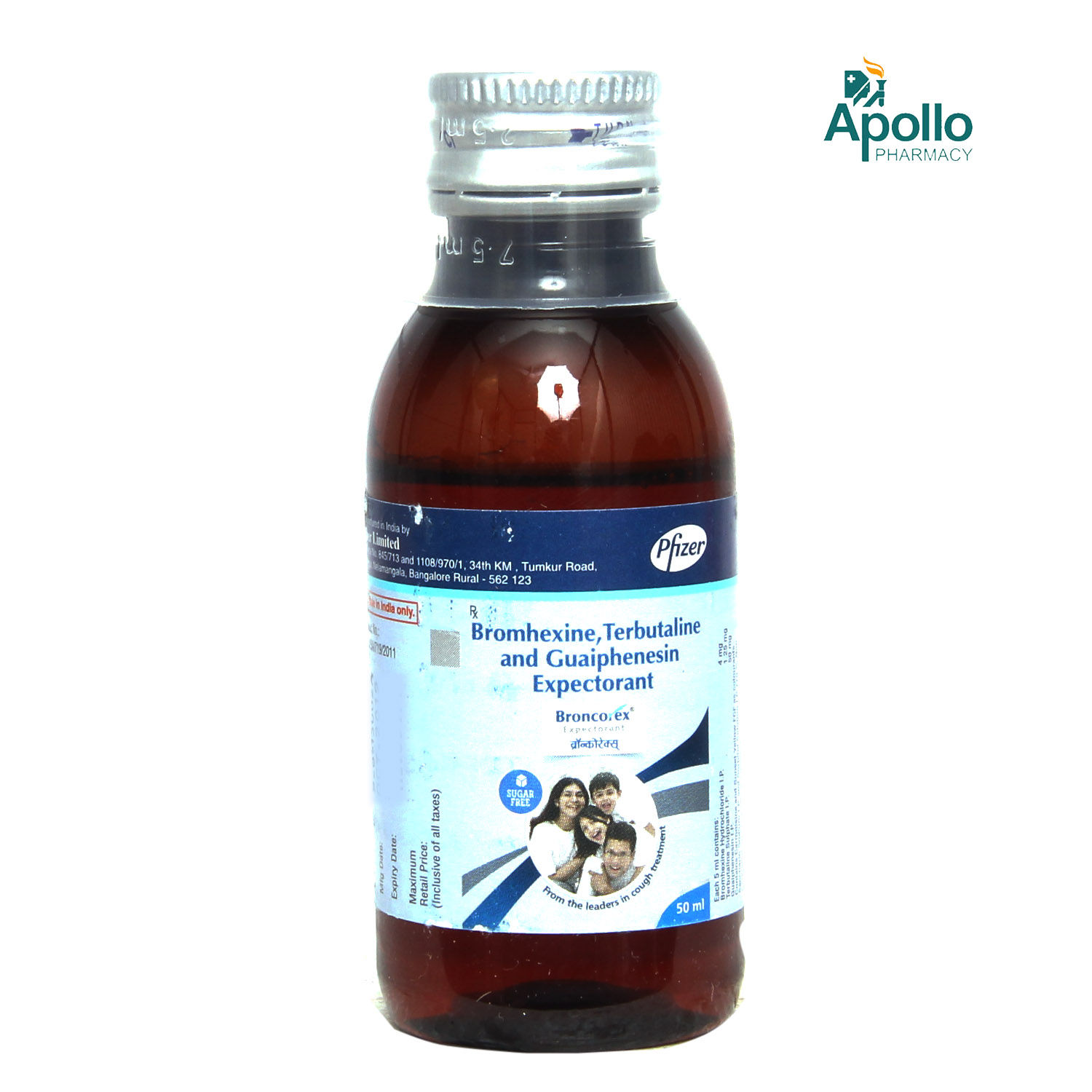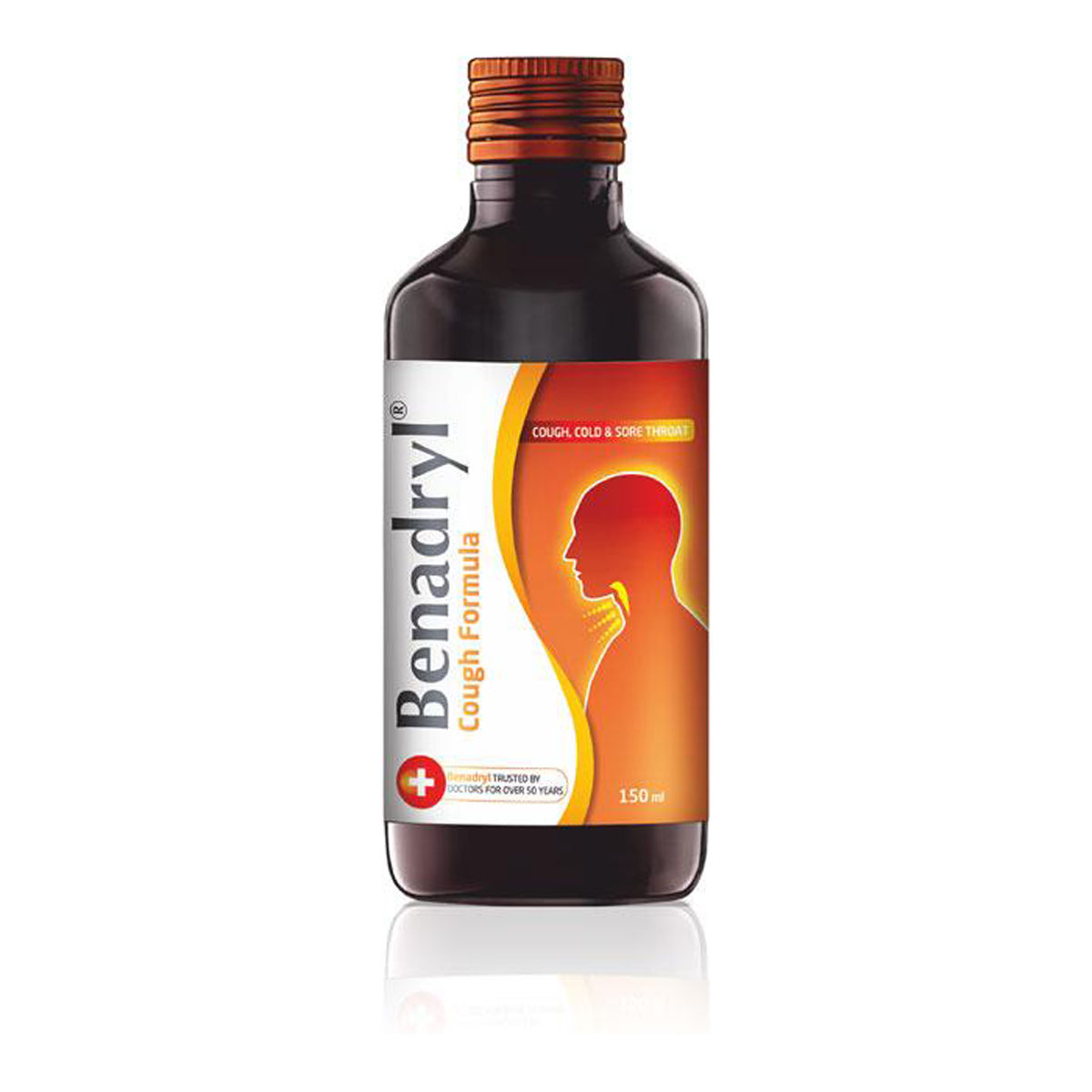Broncorex Expectorant 50 ml



₹62.1*
MRP ₹69
10% off
₹58.65*
MRP ₹69
15% CB
₹10.35 cashback(15%)
Free Delivery
With Circle membership
(Inclusive of all Taxes)
This offer price is valid on orders above ₹800. Apply coupon PHARMA10/PHARMA18 (excluding restricted items)
Know Your Delivery Time
Provide Delivery Location
Selected Pack Size:50 ml
50 ml ₹68.4
(₹1.37 / 1 ml)
In Stock
100 ml ₹139.5
(₹1.4 / 1 ml)
In Stock
Available Offers
 Prescription drug
Prescription drugWhats That

Secure Payment

India's Most Trusted Pharmacy

Genuine Products
Manufacturer/Marketer :
Consume Type :
Return Policy :
Expires on or after :
About Broncorex Expectorant
Broncorex Expectorant belongs to the class of medicine called 'expectorant' primarily used to treat cough associated with mucus. Coughing (dry or productive) is a body's way of clearing irritants (like allergens, mucus or smoke) from airways, thereby preventing respiratory infection. There are two types of coughs, namely: Dry cough and Chesty cough. A dry cough means it's tickly and doesn't produce any vicious or thick mucus, while a chesty cough means mucous or sputum is produced to help clear the airways.
Broncorex Expectorant is a combination of three drugs, namely Guaiphenesin (expectorant), Terbutaline sulphate (bronchodilator) and Bromhexine hydrochloride (mucolytic agent or cough thinner). Guaiphenesin works by increasing the volume of fluid in the airways, reducing the stickiness of mucus and helping to remove it from airways. Terbutaline sulphate relaxes muscles and widens the airways. Thereby, it makes breathing easier. Bromhexine hydrochloride works by thinning and loosening phlegm (mucus) in the lungs, windpipe and nose. Thereby, it helps to cough out easily.
Take Broncorex Expectorant as prescribed. Your doctor will recommend how often you need to take Broncorex Expectorant based on your medical condition. Some people may experience nausea, vomiting, drowsiness, headache, dizziness, skin rash, tremor, stomach upset and fast heartbeats. Most of these side effects of Broncorex Expectorant do not require medical attention and gradually resolve over time. However, if the side effects persist or worsen, please consult your doctor.
If you are known to be allergic to Broncorex Expectorant or any other medicines, please tell your doctor. If you are pregnant or breastfeeding, it is advised to inform your doctor before using Broncorex Expectorant. If you have a history of fits or are suffering from fits, please inform your doctor before taking Broncorex Expectorant as it may increase the risk of recurrent fits. If you have diabetes, regular monitoring of blood sugar levels is recommended while taking Broncorex Expectorant. If you have diabetes, fits, high blood pressure, overactive thyroid, stomach ulcers, phenylketonuria (a congenital disability that causes accumulation of amino acid, phenylalanine in the body), kidney, liver or heart problems, please inform your doctor before taking Broncorex Expectorant.
Uses of Broncorex Expectorant
Directions for Use
Medicinal Benefits
Broncorex Expectorant is a combination of three drugs, namely Guaiphenesin, Terbutaline sulphate and Bromhexine hydrochloride used to treat a cough with mucus. Guaiphenesin belongs to the class of expectorants that works by increasing the volume of fluid in the airways, reducing the stickiness of mucus and helping to remove it from airways. Terbutaline sulphate belongs to the class of bronchodilators that relaxes muscles and widen the airways. Thereby, it makes breathing easier. Bromhexine hydrochloride belongs to the class of mucolytic agents (cough/sputum thinner) that works by thinning and loosening phlegm (mucus) in the lungs, windpipe and nose. Thereby, helps to cough out easily.
How Broncorex Expectorant Works
Storage
Side Effects of Broncorex Expectorant
- Nausea
- Vomiting
- Drowsiness
- Headache
- Dizziness
- Skin rash
- Tremor
- Stomach upset
- Fast heartbeats
What if I have taken an overdose of Broncorex Expectorant
Drug Warnings
If you are known to be allergic to Broncorex Expectorant or any other medicines, please tell your doctor. If you are pregnant or breastfeeding, it is advised to inform your doctor before using Broncorex Expectorant. If you are suffering from fits (epilepsy) or have a history of fits, please inform your doctor before taking Broncorex Expectorant as it may increase the risk of recurrent fits. If you have diabetes, regular monitoring of blood sugar levels is recommended while taking Broncorex Expectorant. If you have diabetes, high blood pressure, overactive thyroid (hyperthyroidism), stomach ulcers/bleeding, phenylketonuria (a congenital disability with high protein in the body), kidney, liver or heart problems, please inform your doctor before taking Broncorex Expectorant.
Drug-Drug Interactions
Drug-Drug Interactions
Login/Sign Up
Combining Tranylcypromine with Broncorex Expectorant 50 ml can increase the risk of high blood pressure.
How to manage the interaction:
Although taking Broncorex Expectorant 50 ml and Tranylcypromine together can evidently cause an interaction, it can be taken if your doctor has suggested it. If you take multiple medications that can raise your blood pressure, it may increase your risk of having high blood pressure while lying down. It's important to regularly check your blood pressure, especially when lying down or with your head elevated, and watch out for any signs of side effects. Do not stop using any medications without a doctor's advice.
Combining Broncorex Expectorant 50 ml and nilotinib can increase the risk of an irregular heart rhythm.
How to manage the interaction:
Taking Broncorex Expectorant 50 ml and nilotinib together can lead to an interaction, it can be taken if advised by your doctor. However, if you experience any symptoms like sudden dizziness, lightheadedness, fainting, shortness of breath, heart palpitations, diarrhea, or vomiting, contact your doctor immediately. Do not discontinue any medications without first consulting your doctor.
Using Broncorex Expectorant 50 ml together with amisulpride can increase the risk of severe irregular heart rhythm.
How to manage the interaction:
Amisulpride and Broncorex Expectorant 50 ml can cause an interaction, but it can be taken if prescribed by a doctor. You should seek immediate medical attention if you develop sudden dizziness, lightheadedness, fainting, shortness of breath, or heart palpitations. Do not stop using any medications without talking to a doctor.
Taking Broncorex Expectorant 50 ml with Ziprasidone can increase the risk of abnormal heart rhythm.
How to manage the interaction:
Co-administration of Ziprasidone with Broncorex Expectorant 50 ml can possibly result in an interaction, but it can be taken together if prescribed by a doctor. However, consult your doctor if you experience sudden dizziness, lightheadedness, fainting, shortness of breath. Do not discontinue any medications without consulting a doctor.
Taking Carvedilol and Broncorex Expectorant 50 ml may reduce the beneficial effects of both medications.
How to manage the interaction:
There may be a possibility of interaction between Broncorex Expectorant 50 ml and Carvedilol, but it can be taken if prescribed by a doctor. Consult your doctor immediately if you experience shortness of breath, palpitations, or chest discomfort. Do not stop using any medications without a doctor's advice.
Co-administration of Labetalol and Broncorex Expectorant 50 ml together can decrease the medical benefits of both medications.
How to manage the interaction:
Although taking Labetalol and Broncorex Expectorant 50 ml together can result in an interaction, it can be taken if a doctor has prescribed it. Do not forget to inform the doctor if you have severe chronic obstructive pulmonary disease (COPD) or a history of asthma, as labetalol is often not advised in these conditions. Do not discontinue any medications without a doctor's advice.
Using sotalol together with Broncorex Expectorant 50 ml may reduce the benefits of both medications since they have opposing effects in the body.
How to manage the interaction:
Taking Sotalol with Broncorex Expectorant 50 ml together can result in an interaction, but it can be taken if a doctor has advised it. Do not stop using any medications without a doctor's advice.
The combined use of Broncorex Expectorant 50 ml and Disopyramide can increase the risk of an irregular heart rhythm.
How to manage the interaction:
Co-administration of Broncorex Expectorant 50 ml and Disopyramide can lead to an interaction, it can be taken if advised by your doctor. However, if you experience any symptoms like sudden dizziness, lightheadedness, fainting, shortness of breath, heart palpitations, diarrhea, or vomiting, contact your doctor immediately. Do not discontinue any medications without first consulting your doctor.
Taking Gatifloxacin and Broncorex Expectorant 50 ml can increase the risk or severity of irregular heart rhythms. The risk increases in patients with a history of heart illness or electrolyte imbalance.
How to manage the interaction:
Taking Gatifloxacin and Broncorex Expectorant 50 ml together can possibly result in an interaction, it can be taken if your doctor has advised it. However, if you experience sudden dizziness, lightheadedness, fainting, shortness of breath, chest pain or tightness, rapid heartbeat, or memory loss, contact a doctor immediately. Do not discontinue any medications without consulting a doctor.
Using propranolol together with Broncorex Expectorant 50 ml may reduce the benefits of both medications, since they have opposing effects in the body. In addition, propranolol can sometimes cause breathing problems.
How to manage the interaction:
Although taking Propranolol together with Broncorex Expectorant 50 ml can possibly result in an interaction, they can be taken together if prescribed by your doctor. However, if you experience any unusual symptoms contact your doctor immediately. Do not stop using any medications without first talking to your doctor.
Drug-Food Interactions
Drug-Food Interactions
Login/Sign Up
Diet & Lifestyle Advise
- Avoid dairy products such as milk as it may increase mucus production. Also, avoid processed or refined foods. Instead, replace baked foods, fried foods, white bread, white pasta, French fries, sugary desserts, and chips with green leafy vegetables.
- Drink plenty of fluids to avoid dry throat while you have a cough. It helps loosen mucus.
- Avoid citrus fruits as they may worsen the cough. Eat fruits rich in water content such as pears, watermelon, peaches, and pineapples.
Habit Forming
Therapeutic Class
Broncorex Expectorant Substitute

Solvin-EX Sugar Free Passion Fruit Expectorant 100 ml
by AYUR
₹1.13per tabletSolvin-EX Expectorant 100 ml
by Others
₹0.94per tabletAscodex BR Syrup 100 ml
by Others
₹0.71per tabletExit Expectorant 100 ml
by Others
₹0.67per tablet
Product Substitutes
Alcohol
Caution
Interaction of alcohol with Broncorex Expectorant is unknown. Please consult a doctor before consuming alcohol with Broncorex Expectorant.
Pregnancy
Caution
The safety of Broncorex Expectorant in pregnant women is unknown. Therefore, it is given to pregnant women only if the doctor thinks benefits outweigh risks.
Breast Feeding
Caution
It is unknown whether Broncorex Expectorant is excreted in human milk. Broncorex Expectorant is given to breastfeeding mothers only if the doctor thinks benefits are greater than risks.
Driving
Caution
Broncorex Expectorant may cause dizziness or drowsiness in some people. Therefore, drive only if you are alert after taking Broncorex Expectorant.
Liver
Caution
Take Broncorex Expectorant with caution, especially if you have a history of Liver diseases/conditions. The dose may be adjusted by your doctor as required.
Kidney
Caution
Take Broncorex Expectorant with caution, especially if you have a history of Kidney diseases/conditions. The dose may be adjusted by your doctor as required.
Children
Caution
Broncorex Expectorant should be used with caution in children and only in doses as prescribed by a doctor.
FAQs
Country of origin
Manufacturer/Marketer address
Customers Also Bought
Disclaimer
Author Details
We provide you with authentic, trustworthy and relevant information




















